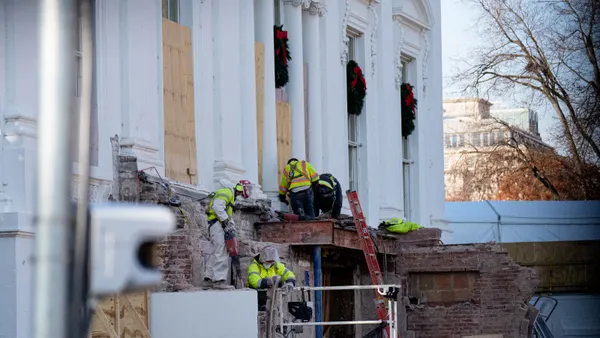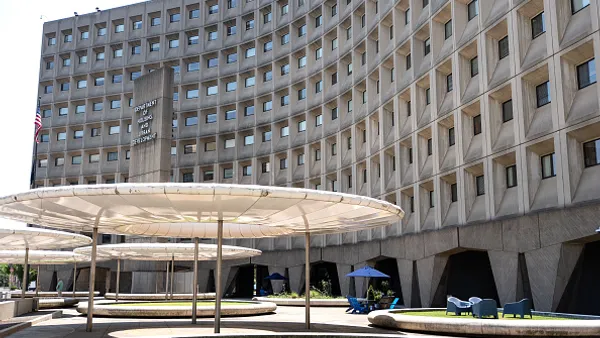Dive Brief:
- A congressionally created panel is recommending disposition of 11 federal properties, including two on the National Mall in Washington, because modernizing the obsolete buildings wouldn’t be cost-effective even if money were available, which it’s not.
- “Investments made today [to dispose of these properties] will generate $1.8 billion in Operating Expense Savings (excluding agency rent) and $5.4 billion in Cost Avoidance over 30 years,” says the Public Buildings Reform Board in its report. “The payback period for these consolidations is two (2) years after taking the one-time capital cost subtracting the sale proceeds and dividing by the Year 1 operating expense.” The properties are expected to generate $346 million in sales proceeds, the board says.
- PBRB was created in 2016 to help the federal government address its sprawling, aging real estate portfolio, which has thousands of underused, obsolete properties facing hundreds of billions of dollars in unmet maintenance and capital needs, according to the Government Accountability Office. About a dozen federal buildings have been disposed of based on previous PBRB reports.
Dive Insight:
The General Services Administration earlier this year released – and then retracted after facing pushback – a proposed disposition list of 443 properties it says are obsolete and underused. GSA’s list included many of the same properties PBRB is recommending for disposal but, unlike GSA, PBRB included a detailed cost-benefit rationale for the properties it listed.
“The Board's … analyses demonstrate that current market conditions offer federal agencies a unique opportunity to relocate to leased spaces that are often of higher quality than existing federal offices, potentially generate revenue for local communities, support federal sustainability goals, and can be optimally configured to better serve agencies' needs,” the report says.
When it retracted its disposition list, GSA attributed the pushback in part to not adequately explaining the rationale for its recommendations. “[We are determining] how we can make it easier for stakeholders to understand the nuances of the assets listed,” Stephanie Joseph, a GSA spokesperson, told Facilities Dive in an email in early March. “We anticipate the list will be republished in the near future.”
Favorable market
In its report, PBRM says the window for disposing of the properties is limited. “This advantageous situation is not permanent,” it says.
Among other things, tenant demand has nearly returned to pre-pandemic levels in many markets, net absorption has flipped positive for the first time since early 2021, rent momentum remains broadly positive, new supply is expected to become more scarce later this year and hybrid employers are requesting more office attendance, according to the report.
These and other trends create a good environment for disposing of the buildings and relocating employees to different spaces, it says.
“Elevated vacancy rates and soft market rents, particularly in underperforming buildings … present an opportunity for the federal government to secure improved leased spaces,” the report says. “Declining absorption rates, reflective of broader occupier downsizing trends, coupled with the ‘Flight to Quality’ movement, are creating a favorable market for government agencies. As private companies upgrade to premium properties, they vacate good-quality spaces. Timely action could allow agencies to capitalize on these market dynamics, securing competitive rental rates in desirable locations.”
What’s more, because the properties are spread throughout the country, no single market would be hit disproportionately by the building sales. “The list does not overwhelm any one market,” the report says.
The list includes three properties in Washington and a single property each in Boston, Chicago, Houston, Atlanta, Miami, Nashville, Albuquerque and Riverdale, Maryland. The Washington properties include two historic buildings on the National Mall: the James V. Forrestal building, which serves as the headquarters for the U.S. Department of Energy, and the Wilbur J. Cohen building, which houses offices of the U.S. Department of Health and Human Services.
PBRB says it’s prepared to recommend more buildings for disposition, but it’s limiting this round because the cost to sell the 11 buildings can be covered by a fund capitalized by proceeds from the sale of the buildings previously recommended by the board.
“The recommended divestments in this report … will not require new taxpayer inputs,” the board says.
The recommendations must be approved by the Office of Management and Budget and reported to Congress and GSA. GSA has the authority to then dispose of the properties.













